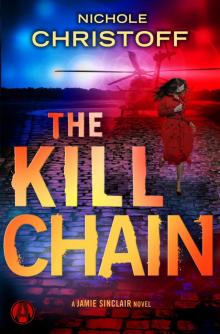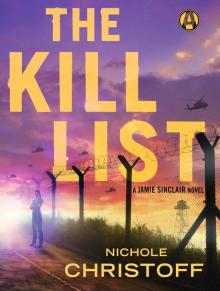- Home
- Nichole Christoff
The Kill Chain Page 9
The Kill Chain Read online
Page 9
While I sipped a second cup of tea, Rain set me up with the in-flight entertainment center, tuned to news channels from around the world. The NHK out of Japan might not have cared about me and the events that had unfolded at Robert Fraley’s, but thanks to my paternity, the Brits’ BBC and the Canadian Broadcasting Corporation did. And so did every network disseminating news in the good ol’ US of A.
In a new bit of breaking news, talking heads told anyone who would listen that the person murdered at Fraley’s place wasn’t actually the robotics engineer himself, but rather US soldier Dylan Pruitt. They rolled footage of the authorities wheeling a sad, black body bag from Fraley’s converted garage. My face flashed across the screen time and again, too. Still considered dangerous, I was labeled a fugitive from justice. My father, the Senator, had refused to offer any comment on the matter.
I felt sick to my very soul.
And then we were on the ground, our plane rolling toward a private terminal. Though it was scarcely past 7 A.M. on the West Coast, that famous California sunshine already drenched the tarmac outside. Palm trees reached for the cloudless sky and a gentle breeze stirred their fronds.
The plane eased into an enormous hangar before drifting to a halt. While the copilot opened the hatch, Rain thanked me for flying with her. She made it sound as if it had been my idea.
She even presented me with a gift bag, overflowing with more white-and-gold tissue, like some kind of party favor. I opened it on the spot to find a handbag—crafted in the workshop of a certain Paris fashion designer and no bigger than a paperback novel—of pebbled leather and tethered to a long, cross-body strap. It was a gorgeous emerald green.
My initials had been inlaid on its front flap.
In gold.
Because Niilo Järvinen, it seemed, was a host who thought of everything.
I slung the beautiful little bag over my shoulder, emerged from the jet, and descended the steps to the hangar floor below. There, a car sat, apparently waiting for me. Another blond chauffeur with a buzz cut and a black suit stood alongside it, except this car wasn’t quite like the one that had picked me up in DC. This car was a Mercedes-Maybach S 650 sedan. And if eight high school teachers pooled their annual salaries, they just might be able to afford one.
At the foot of the gangway, a woman who couldn’t have been more than nineteen years old beamed up at me. She wore her raven-black hair in a ponytail more stylish than mine and red eyeliner winged away from her black-button eyes. She wore a white, flowy blouse and faded jeans with the knees torn out. Her ballet flats matched the crimson of her makeup, and so did the lariat around her neck bearing some kind of key card. In her clasped hands, she carried a sizeable cellphone by a manufacturer I didn’t immediately recognize.
Before I’d so much as stepped from the last stair, she embraced me in a warm cinnamon-scented hug.
“Jamie, we’re so glad to have you visit.” Releasing me, she looked me up and down. “How was your flight? Pleasant, I hope.”
“Oh, yes,” I assured her. “Rain took excellent care of me.”
“Good, good.”
She set off for the car at a brisk pace, her momentum drawing me alongside her.
“I’m Enid,” she said. “I’m Niilo’s First Assistant.”
“First assistant?”
“Yep.”
The driver stepped forward, opened the car door for us. The Maybach’s interior was as clubby as a fine cigar bar. Enid slid across the backseat. I climbed in after her. And if a bevy of Burbank detectives were waiting nearby to arrest me, they might not even get the chance to see me because the car’s windows were heavily tinted.
“Niilo has four assistants,” Enid explained. “As his First Assistant, I organize everything and everybody, from managing his daily calendar to assigning someone to pick up his dry-cleaning. Eco-friendly only, of course.”
“Of course.”
“I get first crack at working out the math, too, when Niilo comes up with a new theory. I live for the math.”
The car came to life with a purr. The driver steered us out of the hangar and into the fresh morning. We rolled between the airport’s terminals as if Niilo Järvinen owned them—and maybe he did.
“Niilo sounds like an exceptional man,” I remarked.
“Oh, he is. And he’s spoken of little besides you since you accepted his invitation. Except he has a pressing meeting this morning that couldn’t be rescheduled. I get to entertain you in the meantime—and get you settled in the Koti.”
“The Koti?”
“That’s what Niilo calls his apartment. It’s more of a penthouse, really. But koti is Finnish, you know, for home.”
“Do you speak Finnish?”
Enid grinned. “I speak Finnish, Hungarian, Estonian, and Russian. Oh, and English, of course. But the first three are related linguistically, so maybe we shouldn’t count each of them.”
“Do you speak all of those languages in the course of your work at Stellar Unlimited?”
“More often than you’d think.”
We exited the airport grounds, turned onto the highway, and drove along the rolling ridges of Southern California’s coastal mountains. Dun brown and dusty green, the landscape was dotted with chaparral and sagebrush, manzanita and Western ragweed. Traffic thickened, slowed like molasses. Our driver exited the highway, then barreled down road after road with discreet gated driveways that led into the hills. He hooked a right and we climbed into a canyon until we came to a compound, complete with a guardhouse out front.
If I was going to be arrested, it would be now, when the guards with serious-looking sidearms stopped the car. But all three of them tipped their hats as we motored past them and onto the campus.
We swerved to the curb in front of a shiny, low-slung building. An architectural element at one end caught the sun’s rays and sent them shining across the roof, only to sweep upward along a steel-like swoop. At the top of this arcing spire, the sunlight got caught up on a metal model of Stellar Unlimited’s iconic four-pointed star and set it sparkling.
“This is our Visitors’ Center,” Enid announced. “We’ll hook you up with an ID inside.”
And that’s exactly what we did.
With all the precision of a military installation’s Pass and ID office, a team of clerks generated a personalized Stellar Unlimited key card bearing my name, my photograph, my visitor status, and a programmable chip that, according to Enid, would grant me access to several of the company’s twenty-nine buildings.
“Which buildings?” I asked her as I clipped the card to my jacket.
Enid merely laughed in reply.
The Visitors Center also boasted a timeline reflecting Niilo Järvinen’s life and work portrayed on Plexiglas panels, a small theater where a mini-documentary about Niilo and Stellar Unlimited ran on a continuous loop, and last but not least, an honest-to-goodness gift shop selling everything from sweatshirts to rocket pops bearing that now-familiar four-pointed star logo. And just in case I made the mistake of thinking Stellar Unlimited–branded merchandise couldn’t possibly be much of a moneymaker, it took three cash registers to ring up the purchases made by a homeschoolers’ field trip, a group of tourists from Tokyo, and a trio of Jesuit priests.
“Come on,” Enid said, consulting her cellphone as I marveled at the place. “It’s nearly time to meet Niilo.”
We exited through an atrium tricked out to look like the surface of the moon—though which moon, I wasn’t sure—and entered a golf cart corral shaded by half a dozen oak trees.
“The golf carts are communal,” Enid explained as we climbed into the one she’d selected. She tapped her Stellar Unlimited ID to a sensor alongside the steering wheel and the vehicle hummed, instantly ready to roll. “Feel free to grab a cart anytime you need to cut across campus.”
“I’ll do that,” I replie
d.
But I was well aware that the handy-dandy pass card that made the motor go would probably provide a clear record of where I’d gone and when.
Enid didn’t bother to mention that fact as she steered the cart onto a wide asphalt concourse.
To the left and the right, new Cubist buildings clung to the craggy canyon sides. Like a toddler’s alphabet blocks, they sat stacked one on top of another. And they were an engineering marvel.
“Eight years ago,” Enid began, and I felt a spiel coming on, “Niilo bought this forty-acre property from Briggs and Barton Aviation, a world-class supplier of gyroscopes and other aviation instruments since 1917. He upgraded three original buildings that dated back to the 1930s, the 1940s, and the 1960s, respectively. One of them was transformed into our Visitors Center. Another became our Press Center.”
Enid pointed to a darkly cool structure crawling with bougainvillea’s brilliant magenta blossoms. Satellite dishes ranged across its roof angled heavenward. In a long lanai notched into the building’s underbelly, and backed once again with Stellar Unlimited’s familiar logo, a series of tripods waited for reporters and camera operators to broadcast live.
“Everything else you see is new construction, built to support our own research and development activities. You’ve got Aeronautic Design, Geo Systems, Space Medicine…”
Enid waved a hand at a series of buildings. Tall, short, narrow, or wide, each was slick with a set of glass tiles sporting a unique pattern. And each glittered in the California sun.
“Robotics, Communications…”
“Interesting fields,” I said, thinking of Robert Fraley and Nathan Rappaport.
But if Enid had any information on those fellows, she didn’t let on. She didn’t stop the cart or offer to show me inside any of these buildings, either. Whether that was by design or simply default, I didn’t know.
But then, we trundled past yet another building.
“Here,” Enid announced, “we have Innovative Engineering—”
“Madeline Donahue’s department.”
Enid regarded me from the corner of her eye.
“You organize ‘everything and everybody,’ ” I said, quoting the young woman’s self-avowed job description. “Ever organize Dr. Donahue?”
“Oh, look! A volleyball game!”
Enid whipped the cart to the side of the paved path, parked beneath some kind of flowering bower. Sure enough, in a grassy glen between a pair of chunky towers, someone had stretched a volleyball net. The players—in their workaday wear of chinos and polo shirts, blue jeans and T-shirts advertising everything from their alma maters to root beer—good-naturedly batted the ball back and forth.
“Play enables the creative process,” Enid said. “It’s a proven fact. Wanna give it a go, Jamie?”
“Maybe later. But don’t let me stop you if you want to get in on the game.”
“Oh, no, I get to play nerd sports every day.” She stepped on the golf cart’s accelerator and shot me a sideways glance. “Besides, it’s time for you to meet Niilo now.”
Chapter 15
Despite Enid’s proclamation—and even after she escorted me into the building at the heart of Stellar International’s campus—I still didn’t get to meet Niilo Järvinen.
And his delay, I was certain, was intentional.
“Here we are, in Niilo’s Koti,” Enid announced, once an elevator had deposited us in a wide workshop mixed with heavy doses of living room on the building’s fifth and top floor. “Come on. I’ll show you to your room.”
She took off, padding down a polished concrete corridor in her bright red ballet flats.
I followed her at a fast clip.
“Kitchen,” she said.
I peeped through a doorway and saw a space dolled up with industrial design.
“In-home gym.”
Along with weights and a state-of-the-art stationary bike, Niilo had a sauna and a small but effective Endless lap pool in there.
“Your room.”
I drew up short when the hallway opened into a bedroom that could’ve doubled as an art gallery.
A swath of windows caught the sun sparkling on the distant metropolis and channeled light into the space to bathe bittersweet landscapes that had been painted by an artist who understood hope and melancholy. Misty grays, mauves, and blues mixed and mingled to suggest twilight over forest and fjord. The color palette had been carried over to the linens on the platform bed, an installation large enough to rival an aircraft carrier’s deck.
On the bedside table, an arcing white sculpture doubled as a lamp. A blocky remote control would no doubt communicate with the flat-screen TV tucked among the paintings, but it probably also controlled the room’s lighting. Beside them both lay something I didn’t expect to see: a cordless telephone sitting bolt upright in its charging cradle.
“Is that a landline?”
“Yep. Dial nine to call out.”
“Is it monitored?”
Enid laughed. “Not by any of us at Stellar Unlimited! Niilo wouldn’t stand for that.”
And as if that were all there was to it, she slid a door aside. “Bath’s through here.”
I glimpsed teakwood and Turkish towels before she moved on to the closet.
“I hope these fit,” she said, slipping another door along its track. “I had to figure out your measurements from photos I found of you on the Internet.”
“More math?”
“I live for the math.”
Black trousers, indigo-blue jeans, and white ankle pants had been clipped to rosewood hangers. Thick, fancy T-shirts of pima cotton in black, white, pale blue, and blush had been neatly folded on the shelf to the left. The black patent flats in the bottom of the closet looked expensive. So did the trim black jacket, with a belt and plenty of pockets. And none of it, I noticed, clashed with my brand-new handbag.
But every article was functional. Just like my wardrobe back home. Which meant someone had been paying close attention to what I wore and why.
“You’ve chosen great pieces,” I told Enid. “Thank you.”
“Oh, Niilo selected everything. Niilo admires form.” And with an arch appraisal of my own, Enid added, “By the way, his bedroom is on the other side of the apartment.”
“Good to know,” I muttered.
But as far as I was concerned, Niilo Järvinen had better stay there.
We returned to the expansive great room.
“Have a seat,” Enid said.
She gestured to a collection of svelte sofas and engineered-wood chairs clustered on a wool rug. The striated colors in the rug were reminiscent of the California sunset—or maybe Finland’s sunrise. An L-shaped desk angled behind it. Six supersized touch screens, probably meant to work like whiteboards that downloaded every scribble onto a hard drive or uploaded them onto the cloud, stood in a semicircle beside the desk. One was covered in a mathematical equation I had no hope of figuring out.
The rest were dark.
At the far end of the room, windows reached from one wall to the other and from floor to ceiling. Natural light poured in and brought with it a breathtaking view of canyon upon canyon. But it was the long soapstone workbench placed before them that drew my attention and held it. Delicate tools, a microscope, and a vise stood in orderly rows between models that could’ve been built from sheet plastic, tension wire, ceramic insulators, or Space Age Tinkertoys. Bins beneath the bench held more gadgets. Mylar, microcircuits, and minuscule fittings I couldn’t name had been laid out neatly. The contraptions assembled from them must’ve been Niilo Järvinen’s inventions, and more than one looked like it could’ve taken flight or been built on a grand scale to shelter life on a distant world.
“Niilo will be a few more moments,” Enid said, with her eyes on her cellphone. “Please. Take a look around, if y
ou’d like.”
She departed.
And I suspected, in this part of the Koti at least, that hidden cameras could be recording my movements as well as my reactions as I did so.
Jamming my hands into my jacket pockets, I strolled to a 3-D printer buzzing away under an exhaust hood and peered through its viewing window. The gadget inside, formed by a series of interconnected spheres, was like no mechanical component I’d ever seen. Neither were the framed patent applications decorating the wall above it.
I perused a few of those.
Until the back wall, behind the L-shaped desk, began to glow a pearly gray.
Like a television screen, the width of the wall came to life with a scene. Shadowy figures loomed on the right-hand side. But on the left, an extreme close-up revealed the high cheekbone and bright, clear eye of a man I’d never met.
“I assure you,” he said. “This has never happened at my company.”
I knew that voice and its distinctive accent.
They belonged to Niilo Järvinen.
And I wasn’t sure whether he was speaking to me or the people in the room with him.
He addressed us both, I realized, when he stepped back. I could see the rest of him now: narrow, Nordic shoulders and naturally white hair that had had the benefit of a Hollywood stylist.
I could see the others now, too. Two men and two women. They sat on angular tubular-steel-and-leather chairs in a cool conversation group.
One of the men was Special Agent McIlvoy.
The other was Lieutenant Colonel Adam Barrett.
Barrett wasn’t in uniform, but that didn’t mean he wasn’t on the job. The collar of his cobalt-blue shirt was just as starched as any shirt he wore on duty. And I wouldn’t have been surprised to discover his taupe jacket hid a firearm on his hip.
The woman at Barrett’s elbow was Jenna Shelby, a most capable soldier and a military cop who’d served under his command at Fort Leeds, New Jersey. She wore civilian clothes as well: a collarless blouse that didn’t touch the curls she’d wrangled into a coil at the nape of her neck, and trousers, and good leather shoes that wouldn’t slow her down.

 The Kill Wire
The Kill Wire The Kill Box
The Kill Box The Kill Radius
The Kill Radius The Kill Shot
The Kill Shot The Kill Chain
The Kill Chain The Kill List
The Kill List